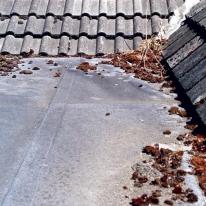Steel internal gutters – corrosion (rusting)
Cause
Water doesn't drain away
Repair
-
address the lack of drainage. If it is a result of blocked outlets, unblock the outlets. If it is the result of lack of appropriate fall to the outlet(s), rebuild the guttering with a fall so that water does not sit in the gutter for long periods. Although the Acceptable Solution E2/AS1 requires a minimum slope of 1:100 for internal gutters, BRANZ recommends a minimum 1:60 fall for better drainage
-
closely examine the condition of the guttering. Where rust has corroded right through the metal, or is close to doing that, then the steel guttering should be replaced. Where rusting is minor it should be removed with sanding. Paint with a zinc-rich primer and then at least two coats of acrylic paint
-
given that creating an appropriate fall for the gutter may require significant work, it may be easier to install a new gutter rather than reuse the old one. The Acceptable Solution E2/AS1 (8.1.6.1) limits the materials that can be used for internal gutters to butyl or EPDM membrane, or aluminium, copper, stainless steel or zinc sheets with welded joints. Ensure that products and materials used are installed in line with manufacturers’ recommendations
-
internal gutters can be problematic and increase the risk of leaks in a roof, so any construction work on them should be carried out by a person with the appropriate skills, experience and equipment. This is not work for a novice. Work on roofs is restricted building work under the Building Act and anyone engaged to carry out this work must be a licensed building practitioner or be supervised by an LBP
-
check the gutter annually for damage or deterioration to the lining and outlet(s)
Cause
Leaves or other debris retain moisture and prevent water from draining away
Repair
-
clear debris out of the gutter and/or overflow (aim to do this every three months if the problem recurs)
-
trim back branches that overhang the roof until they are well clear
-
closely examine the condition of the guttering. Where rust has corroded right through the metal, or is close to doing that, then the steel guttering should be replaced. (The Acceptable Solution E2/AS1 (8.1.6.1) limits the materials that can be used for internal gutters to butyl or EPDM membrane, or aluminium, copper, stainless steel or zinc sheets with welded joints.) Where rusting is minor it should be removed with sanding. Paint with a zinc-rich primer and then at least two coats of acrylic paint
-
check the gutter annually for damage or deterioration to the lining and outlet(s)
Cause
Metal debris (swarf and roof offcuts) were left in the bottom of the gutter when the roof was installed
Repair
-
clear all debris out of the gutter
-
closely examine the condition of the guttering. Where rust has corroded right through the metal, or is close to doing that, then the steel guttering should be replaced. (The Acceptable Solution E2/AS1 (8.1.6.1) limits the materials that can be used for internal gutters to butyl or EPDM membrane, or aluminium, copper, stainless steel or zinc sheets with welded joints.) Where rusting is minor it should be removed with sanding. Paint with a zinc-rich primer and then at least two coats of acrylic paint
-
check the gutter annually for damage or deterioration to the lining and outlet(s)
Cause
Incompatible metals have been put together resulting in corrosion – for example, copper guttering with galvanised steel inserts
Repair
-
galvanic corrosion can occur when two incompatible materials are in direct contact with each other in the presence of moisture, or water runs from one onto another one of the materials should be replaced with a material compatible to the other. For example, if copper guttering is fixed with galvanized steel brackets, replace the steel brackets with brackets made of brass
-
repair or replace the rusted guttering as described above
Cause
The material is at the end of its serviceable life
Repair
-
the steel guttering should be replaced. The Acceptable Solution E2/AS1 (8.1.6.1) limits the materials that can be used for internal gutters to butyl or EPDM membrane, or aluminium, copper, stainless steel or zinc sheets with welded joints
-
given the fact that internal gutters can be problematic and increase the risk of leaks in a roof, any construction work on them should be carried out by a person with the appropriate skills, experience and equipment. This is not work for a novice. Work on roofs is restricted building work under the Building Act and anyone engaged to carry out this work must be a licensed building practitioner or be supervised by an LBP
-
ensure that the substrate is appropriate for the material – for example, lack of sufficient fall and excess movement in substrates can both lead to membrane failure. Ensure that products used are installed in line with manufacturers’ recommendations
-
check the gutter annually for damage or deterioration to the lining and outlet(s)
Cause
Wrong specification for the environment
Repair
- as for “The material at the end of its serviceable life” above






